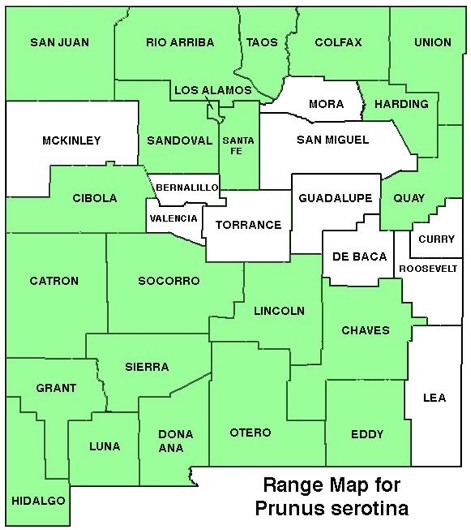WILDFLOWERS OF NEW MEXICO

Shrubs or small trees 3–25 feet tall in NM are thornless with no root suckers, and have glossy, elliptical leaves with 15–30 lateral veins. Note the dense, elongated clusters of small white flowers, and the dark red to black berries loved by wildlife. Trees in eastern forests can reach 100 feet tall.
FLOWERS: April–July. Dense, elongated clusters 1 1/4–4 inches long (3–10 cm) bloom with 18–55 small flowers after leaves emerge; flowers to 1/2 inch across (12 mm) with 5 rounded petals. Fruit are drupes, 1/4–1/2 inch diameter (6-8 mm), juicy, maturing dark red to black. Note the reddish, pointed calyx (sepal) lobes remain at the base of the fruit as the drupe matures from green to red to black.
LEAVES: Alternate, stalked. Blades elliptic to oblong with pointed tips, 3/4–2 3/4 inches long (2–7 cm); edges with tiny, incurved to flat lying teeth, rounded to finely serrated, often callus-tipped; top surfaces smooth, bottom hairy along midrib. Note the lateral veins 15–30 per side, smooth (not raised) on the bottom surface.
HABITAT: Stream sides, canyon bottoms, forest edges, open woodlands; pinyon-juniper-Gambel oak foothills, ponderosa pine-Douglas fir forests.
ELEVATION: 4,500–8,000 feet (1372–2438 m).
RANGE: AZ, NM, TX; widespread throughout eastern half of North America, into Mexico.
SIMILAR SPECIES: Western Chokecherry, P. virginiana, has leaves with fine teeth that spread from the edge, 6–18 veins with the veins raised on the bottom surface, and no pointed calyx (sepal) lobes at the base of the ripening fruit.
NM COUNTIES: Widespread in central and western NM in mid-elevation, moist habitats: Catron, Chaves, Cibola, Colfax, Dona Ana, Eddy, Grant, Harding, Hidalgo, Lincoln, Los Alamos, Luna, Otero, Quay, Rio Arriba, San Juan, Sandoval, Santa Fe, Sierra, Socorro, Taos, Union.









BLACK CHERRY
PRUNUS SEROTINA
Rose Family, Rosaceae
Deciduous shrub to small tree


















THE CONTENTS OF THIS WEBSITE ARE COPYRIGHTED AND CANNOT BE USED
WITHOUT PERMISSION OF GEORGE OXFORD MILLER


















Fruit matures into a dark purple to black drupe. Note the sepals at the base of the fruit retain their pointed tips (arrow).



















• Leaves have 15–30 lateral veins (left arrow).
• Leaf edges have incurved to flat lying teeth, rounded to finely serrated, often callus-tipped (right arrow).


EMAIL ME
























